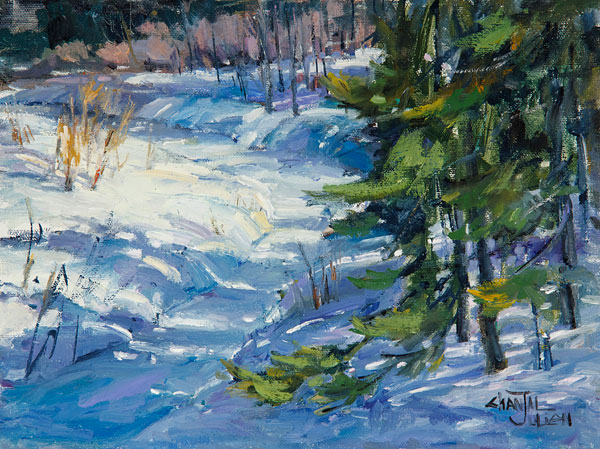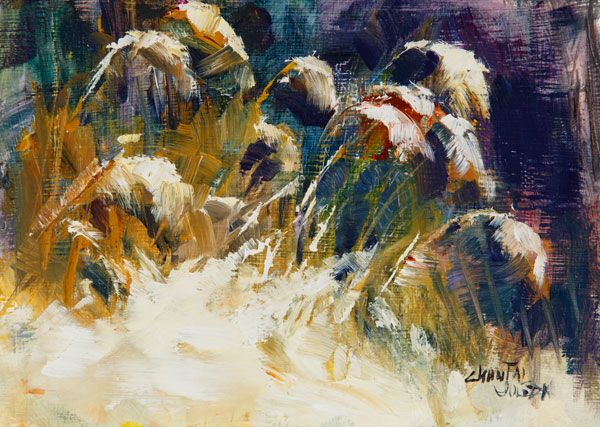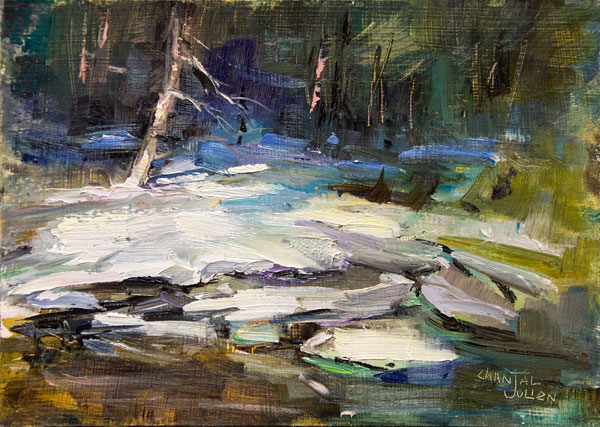Chantal Julien
la dualité / the duality
Par/by Gilles Fisette





Un temps, Chantal Julien a délaissé la peinture pour la sculpture.
"Parce qu'une amie en faisait, je me suis dit que j'allais essayer la sculpture en papier mâché. Pour le défi.
Je me suis mise à sculpter des oiseaux alors que je n'en peins jamais... La première sculpture était un envol d'oies. Rien de simple, en effet...
Pour défier la gravité, je devais trouver le moyen de tout faire tenir avec de la broche. J'ai fait ça parce que j'aime résoudre des problèmes et créer mes propres outils", explique-t-elle en précisant qu'elle a toutefois rapidement délaissé la sculpture qui grugeait trop de son temps pour revenir à sa véritable passion pour la peinture. Mais ce court passage illustre bien les deux personnes qui habitent Chantal Julien.
Il y a l'artiste et il y a la scientifique.
Née à Donnacona, dans le comté de Portneuf, elle est diplômée de La Pocatière, en technologie. Elle a travaillé dans un laboratoire de recherche de l'Université de Sherbrooke ainsi qu'au sein d'une entreprise de refroidisseurs d'eau avant de laisser toute la place, enfin presque, à l'artiste en elle.
Presque?
"Mon côté scientifique n'est jamais très loin et il me permet de mener des recherches quand je veux résoudre un problème. Je fais des tests de couleurs, de médiums. Le côté scientifique me permet de me questionner et de savoir pourquoi quelque chose ne marche pas."
Toutefois, quand elle peint, elle doit laisser l'artiste s'exprimer totalement et librement, sans questionnement, sans hésitation. "Quand je peins, je suis instinctive. Si je me mets à analyser mon travail pendant que je peins, je bloque. Je dois travailler sans me questionner. Je dois laisser le cerveau gauche lousse. Je dois rentrer dans une bulle et quand j'ai terminé, il m'arrive de me dire: wow, où étais-je quand j'ai peint cela!"
Chantal Julien peint surtout des scènes en extérieur.
"Il m'arrive de peindre à partir d'une photo mais il n'y a rien comme de peindre sur place, dans la nature.
Avec une photo, ce qui t'avait intéressé n'est plus là.
Souvent pour une question de lumière et aussi d'ambiance, d'atmosphère et, même, de bruit ou d'odeur... Mais ce qui a d'abord capté mon attention, c'est la
lumière. C'est à partir d'elle que je compose mon tableau", explique-t-elle en ajoutant que, si elle est un temps sans aller peindre dans la nature, elle sent que
"mes couleurs ne sont plus ajustées".
Sa technique évolue sans cesse.
Progressivement, elle laisse une grande part à l'abstraction dans ses tableaux. Les contours et les formes deviennent moins bien définis.
"Là où je veux que le regard porte, c'est plus défini.
Pour le reste, c'est plus abstrait. Je ne fais pas une
reproduction fidèle de ce que je vois.
Je l'interprète.
Je le simplifie... "
Chantal Julien est une femme très active.
Au fil des années, elle a participé à nombre de symposiums et d'expositions. Cela l'a amenée aussi loin qu'à Sakai et Kyoto, au Japon, et à Monastir, en Tunisie où on peut retrouver des oeuvres de sa main. Ses tableaux font également partie de plusieurs collections publiques et privées au Québec, au Canada, aux États-Unis et en Europe.
__
For a while, Chantal Julien abandoned painting for sculpture.
"Because a friend was doing it. I said to myself that was going to try my hand at paper mache sculpting.
For the challenge.
I started sculpting birds even though I had never painted any ... The first sculpture was a flight of geese.
Nothing simple, indeed ... To defy gravity, I had to find a way to hold it all together with spindle. I did this because I like to solve problems and create my own tools, "she explains, specifying that she however quickly abandoned the project which wasted too much of her time to return to her true passion, painting. But this short passage illustrates the two people who live in Chantal Julien.
There is the artist and there is the scientist.
Born in Donnacona, in the community of Portneuf, she graduated from La Pocatière, in technology. She worked in a research laboratory at the University de Sherbrooke as well as a water cooler company before devoting all of herself, well almost, to the artist in her.
Almost?
"My scientific side is never very far away, and it allows me to conduct research when I want to solve a problem. I do color tests and trials on mediums. The scientific side allows me to question myself and know why something is not working. "
However, when she paints, she must let the artist express herself fully and freely, without questioning, and without hesitation"When I paint, I am instinctive.
If I start to analyze my work while in progress, I block.
I must work without questioning myself. I must leave the left brain free. I have to get into the zone and sometimes when I'm done, I look at my work and think wow, where was I when I painted this! "
Chantal Julien mainly paints outdoors.
"Sometimes I paint from a picture but there is nothing like painting on site, in nature.
With a photo, what interested you is no longer there.
Often there is a question of light and of ambiance, atmosphere and, even, noise or smell ... But what first caught my attention was the light. It is from that that I compose my painting ", she explains in adding that,
if there she is a while without painting in nature,
she feels that "my colors are no longer adjusted".
Her technique is constantly evolving.
Gradually, she leaves a large part to abstraction in her paintings.
Outlines and shapes become less well defined.
"Where I want the gaze to go, it's more defined.
For the rest, it is more abstract. I am not making a
faithful reproduction of what I see.
I interpret it.
I simplify it ... "
Chantal Julien is a very active woman. Over the years she has participated in number of symposiums and exhibitions. These brought her as far as Sakai and Kyoto, Japan, and Monastir, Tunisia where you can find works by this artist. Her paintings are also part of several public collections and private ones in Quebec, Canada, the United States and Europe.
